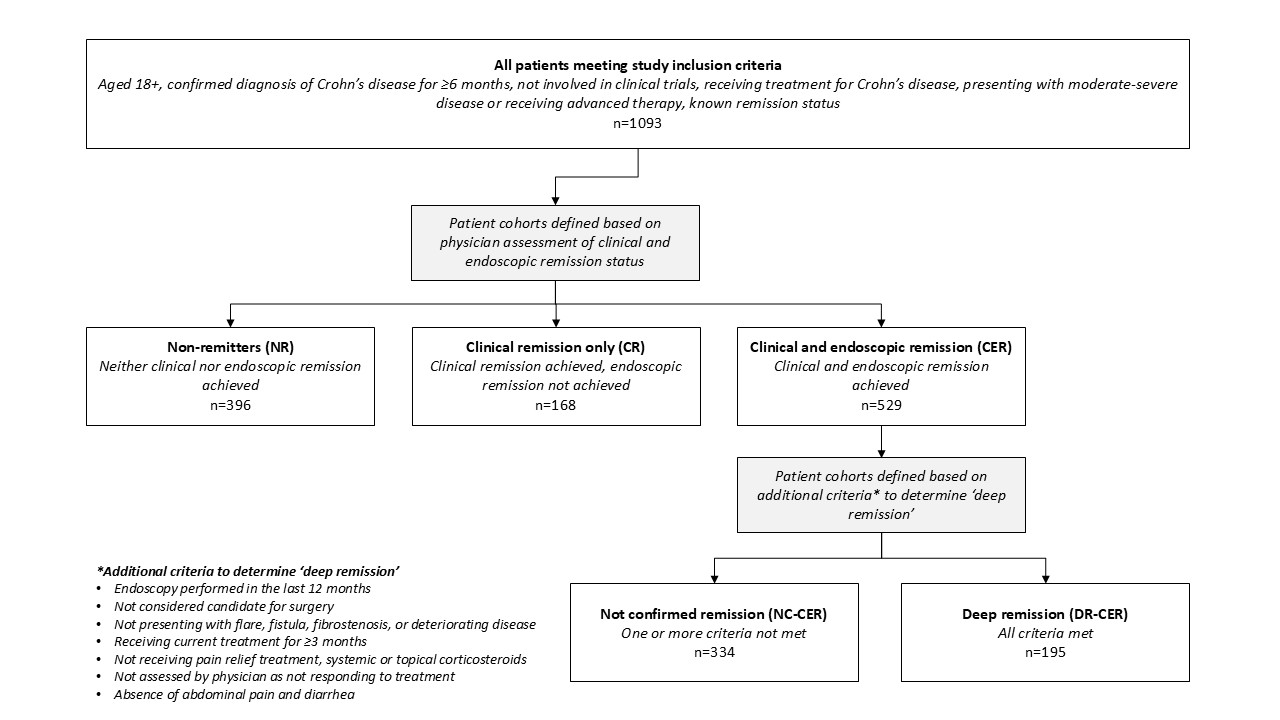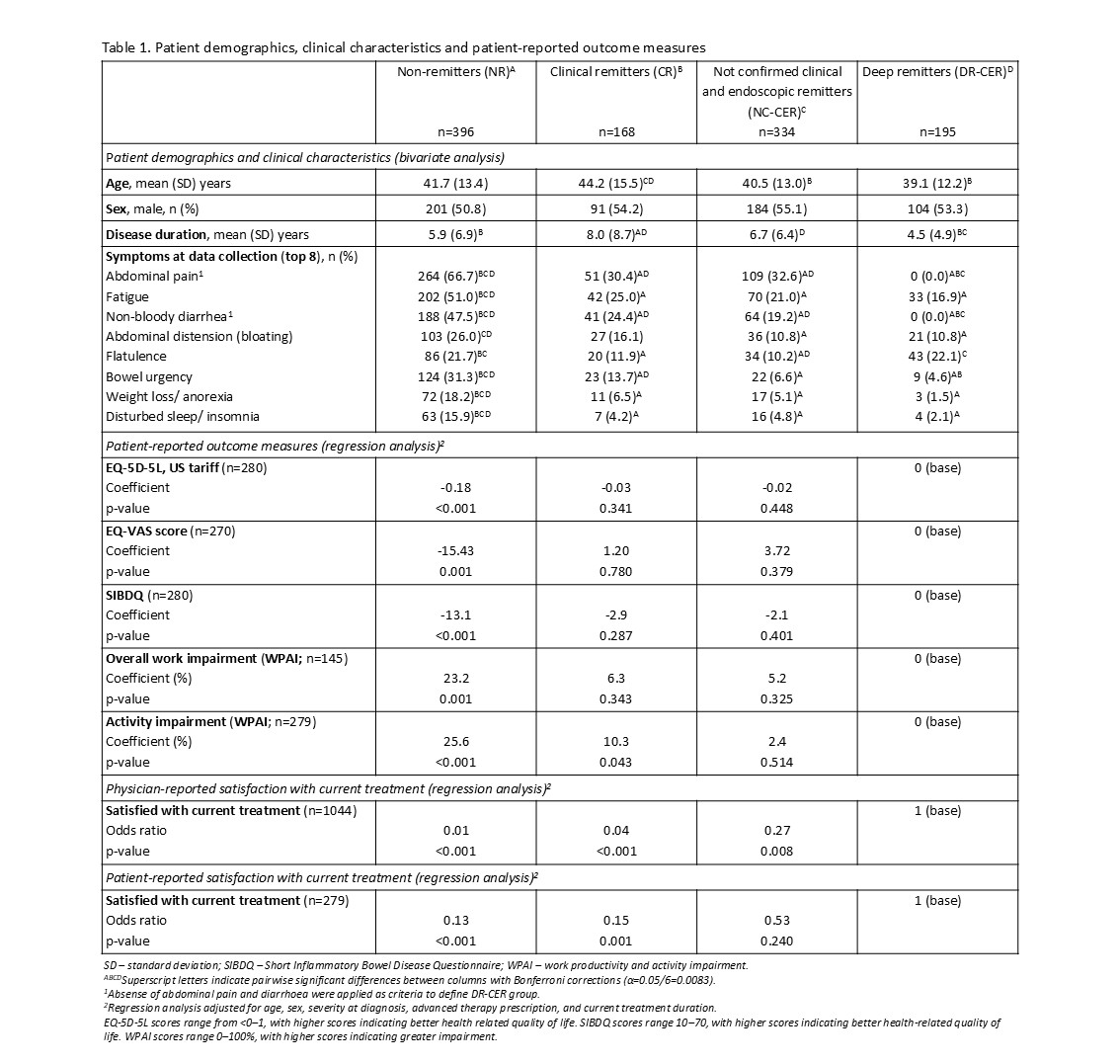Monday Poster Session
Category: IBD
P3244 - Symptom and Quality of Life Benefits of Achieving Deep Remission – A Real-World Survey of Patients With Crohn’s Disease
Monday, October 27, 2025
10:30 AM - 4:00 PM PDT
Location: Exhibit Hall

Myrlene Sanon, MPH
Johnson & Johnson
Metuchen, NJ
Presenting Author(s)
Myrlene Sanon, MPH1, Hannah Knight, MSc2, Rachael Meadows, MSc2, Alexa Russnak, MSCR2, Elise Wu, 3, Sumesh Kachroo, PhD4
1Johnson & Johnson, Metuchen, NJ; 2Adelphi Real World, Bollington, England, United Kingdom; 3Johnson & Johnson, Raritan, NJ; 4Johnson & Johnson, Horsham, PA
Introduction: Latest clinical guidelines define deep remission in Crohn’s disease (CD) as clinical remission, biomarker normalization, endoscopic healing and restored quality of life (QoL). While deep remission is the ultimate treatment goal, its benefits over partial healing remain unclear. We assessed treatment satisfaction, symptomatic and QoL benefits of deep remission.
Methods: Data were drawn from the Adelphi Real World CD Disease Specific Programme™, a cross-sectional survey of gastroenterologists (GIs) and their patients with CD in France, Spain, Germany, Italy, the United Kingdom and the United States, collected Feb 2023-Oct 2024. Moderate-severe patients diagnosed with CD ≥6 months, receiving treatment at survey were included. GIs reported patient demographics, clinical status and treatment satisfaction. Patients reported treatment satisfaction and QoL via EQ-5D-5L (US tariff), EQ-VAS, the Short Inflammatory Bowel Disease Questionnaire (SIBDQ) and the Work Productivity and Activity Impairment questionnaire. Patients were defined as non-remitters (NR), achieved clinical remission only (CR), or achieved both clinical and endoscopic remission (CER). CER was subdivided into deep remission (DR-CER) and not confirmed remission (NC-CER) (Figure 1). Pairwise group comparisons used Bonferroni corrected t-tests and Fisher’s exact test (α=0.05/6=0.0083). Regression coefficients (coef) and odds ratios (OR) compared QoL outcomes and satisfaction.
Results: Among 1093 patients (396 NR, 168 CR, 334 NC-CER, 195 DR-CER), mean (standard deviation) age was 41.3 (13.5) years, 53.1% were male (Table 1). Fatigue, abdominal distension, weight loss/anorexia, and disturbed sleep/insomnia were more common in NR patients and bowel urgency was more common in CR and NR patients than DR-CER (all p< 0.0083). NR had lower EQ-5D-5L (coef: -0.18), EQ-VAS (coef: -15.43) and SIBDQ scores (coef: -13.1), and higher overall work impairment (coef: 23.2) than DR-CER (all p≤0.001). Activity impairment was higher for NR (coef: 25.6, p< 0.001) and CR (coef: 10.3, p< 0.05) than DR-CER. Physician-reported (OR: NR 0.01, CR 0.04) and patient-reported (OR: NR 0.13, CR 0.15) treatment satisfaction was lower for NR and CR than DR-CER (all p≤0.001)
Discussion: Patients with CD achieving deep remission had improved symptoms, QoL, work productivity and greater treatment satisfaction compared to NR. The residual burden in CR patients highlights a need for more effective therapies to achieve deep remission.

Figure: Figure 1. Patient inclusion criteria and group definitions

Figure: Table 1. Patient demographics, clinical characteristics and patient-reported outcome measures
Disclosures:
Myrlene Sanon: Johnson & Johnson – Employee.
Hannah Knight indicated no relevant financial relationships.
Rachael Meadows indicated no relevant financial relationships.
Alexa Russnak indicated no relevant financial relationships.
Elise Wu: Johnson and Johnson – Employee.
Sumesh Kachroo: Johnson & Johnson – Employee, Stock Options.
Myrlene Sanon, MPH1, Hannah Knight, MSc2, Rachael Meadows, MSc2, Alexa Russnak, MSCR2, Elise Wu, 3, Sumesh Kachroo, PhD4. P3244 - Symptom and Quality of Life Benefits of Achieving Deep Remission – A Real-World Survey of Patients With Crohn’s Disease, ACG 2025 Annual Scientific Meeting Abstracts. Phoenix, AZ: American College of Gastroenterology.
1Johnson & Johnson, Metuchen, NJ; 2Adelphi Real World, Bollington, England, United Kingdom; 3Johnson & Johnson, Raritan, NJ; 4Johnson & Johnson, Horsham, PA
Introduction: Latest clinical guidelines define deep remission in Crohn’s disease (CD) as clinical remission, biomarker normalization, endoscopic healing and restored quality of life (QoL). While deep remission is the ultimate treatment goal, its benefits over partial healing remain unclear. We assessed treatment satisfaction, symptomatic and QoL benefits of deep remission.
Methods: Data were drawn from the Adelphi Real World CD Disease Specific Programme™, a cross-sectional survey of gastroenterologists (GIs) and their patients with CD in France, Spain, Germany, Italy, the United Kingdom and the United States, collected Feb 2023-Oct 2024. Moderate-severe patients diagnosed with CD ≥6 months, receiving treatment at survey were included. GIs reported patient demographics, clinical status and treatment satisfaction. Patients reported treatment satisfaction and QoL via EQ-5D-5L (US tariff), EQ-VAS, the Short Inflammatory Bowel Disease Questionnaire (SIBDQ) and the Work Productivity and Activity Impairment questionnaire. Patients were defined as non-remitters (NR), achieved clinical remission only (CR), or achieved both clinical and endoscopic remission (CER). CER was subdivided into deep remission (DR-CER) and not confirmed remission (NC-CER) (Figure 1). Pairwise group comparisons used Bonferroni corrected t-tests and Fisher’s exact test (α=0.05/6=0.0083). Regression coefficients (coef) and odds ratios (OR) compared QoL outcomes and satisfaction.
Results: Among 1093 patients (396 NR, 168 CR, 334 NC-CER, 195 DR-CER), mean (standard deviation) age was 41.3 (13.5) years, 53.1% were male (Table 1). Fatigue, abdominal distension, weight loss/anorexia, and disturbed sleep/insomnia were more common in NR patients and bowel urgency was more common in CR and NR patients than DR-CER (all p< 0.0083). NR had lower EQ-5D-5L (coef: -0.18), EQ-VAS (coef: -15.43) and SIBDQ scores (coef: -13.1), and higher overall work impairment (coef: 23.2) than DR-CER (all p≤0.001). Activity impairment was higher for NR (coef: 25.6, p< 0.001) and CR (coef: 10.3, p< 0.05) than DR-CER. Physician-reported (OR: NR 0.01, CR 0.04) and patient-reported (OR: NR 0.13, CR 0.15) treatment satisfaction was lower for NR and CR than DR-CER (all p≤0.001)
Discussion: Patients with CD achieving deep remission had improved symptoms, QoL, work productivity and greater treatment satisfaction compared to NR. The residual burden in CR patients highlights a need for more effective therapies to achieve deep remission.

Figure: Figure 1. Patient inclusion criteria and group definitions

Figure: Table 1. Patient demographics, clinical characteristics and patient-reported outcome measures
Disclosures:
Myrlene Sanon: Johnson & Johnson – Employee.
Hannah Knight indicated no relevant financial relationships.
Rachael Meadows indicated no relevant financial relationships.
Alexa Russnak indicated no relevant financial relationships.
Elise Wu: Johnson and Johnson – Employee.
Sumesh Kachroo: Johnson & Johnson – Employee, Stock Options.
Myrlene Sanon, MPH1, Hannah Knight, MSc2, Rachael Meadows, MSc2, Alexa Russnak, MSCR2, Elise Wu, 3, Sumesh Kachroo, PhD4. P3244 - Symptom and Quality of Life Benefits of Achieving Deep Remission – A Real-World Survey of Patients With Crohn’s Disease, ACG 2025 Annual Scientific Meeting Abstracts. Phoenix, AZ: American College of Gastroenterology.
